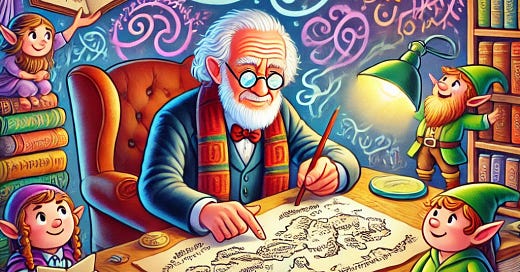The Languages of Middle-earth
How J.R.R. Tolkien Brought Middle-earth to Life with His Invented Tongues 📜🖋️
The Magical Tongues of Middle-earth: Exploring the Languages Created by J.R.R. Tolkien
J.R.R. Tolkien, the brilliant mind behind The Lord of the Rings and The Hobbit, wasn’t just a master storyteller—he was also a passionate philologist who loved languages. In fact, his dedication to linguistics played a central role in shaping the world of Middle-earth. Let’s dive into the rich tapestry of languages Tolkien created and how they added depth and realism to his fantasy universe.
Why Tolkien Created Languages
Tolkien’s fascination with languages began long before Middle-earth came to life. As a scholar of Old English and Norse, and later a professor at Oxford, he studied the roots of many languages. He believed that languages and stories were deeply intertwined, and this philosophy inspired him to create fictional tongues as the foundation of his world-building.
The Core Languages of Middle-earth
Here are some of the most prominent languages Tolkien crafted for The Lord of the Rings and the cultures they represent:
1. Quenya (High Elvish)
Inspired by: Finnish, Latin, and Greek.
Who speaks it: The High Elves (Noldor and Vanyar) and scholars of Middle-earth.
Details: Quenya is a formal and ancient language, often used for poetry, song, and ceremonial purposes. It’s known for its melodic, flowing quality, reflecting the grace of the Elves.
Example Phrase: Elen síla lúmenn’ omentielvo ("A star shines on the hour of our meeting").
2. Sindarin (Common Elvish)
Inspired by: Welsh and Old English.
Who speaks it: Most Elves in Middle-earth, especially those in Rivendell and Lórien.
Details: Sindarin is the "everyday" language of the Elves. It’s a descendant of Quenya but more widely used, especially in the Third Age.
Example Phrase: Mae govannen ("Well met").
3. Khuzdul (Dwarvish)
Inspired by: Semitic languages, particularly Hebrew.
Who speaks it: The Dwarves.
Details: Khuzdul is a secretive language, closely guarded by the Dwarves and rarely shared with outsiders. Its guttural sounds reflect the toughness and resilience of its speakers.
Example Phrase: Baruk Khazâd! Khazâd ai-mênu! ("Axes of the Dwarves! The Dwarves are upon you!").
4. Black Speech
Who speaks it: Servants of Sauron, including orcs.
Details: This harsh and brutal language was designed by Sauron to unify his followers. It reflects the oppressive and malevolent nature of Mordor.
Example Phrase: Ash nazg durbatulûk ("One ring to rule them all").
5. Westron (Common Speech)
Who speaks it: The "common tongue" used by most people in Middle-earth, including Hobbits.
Details: While Westron itself is not detailed in Tolkien’s works, it’s described as the language of communication between different races and cultures. Tolkien represented it in the books using modern English.
How Tolkien Developed His Languages
Tolkien’s language creation involved much more than inventing words. He developed grammar, syntax, and even dialects. For instance:
Elvish Languages: Quenya and Sindarin are related, much like Latin and its Romance descendants. They share linguistic roots in "Primitive Quendian," the proto-language of the Elves.
Writing Systems: Tolkien designed unique alphabets, such as Tengwar for Elvish and Cirth for Dwarvish. These writing systems added authenticity and visual appeal to his languages.
The Influence of Real-World Languages
Tolkien’s deep knowledge of real-world languages inspired much of his linguistic creativity:
Finnish influenced Quenya’s phonetics and grammar.
Welsh shaped the sounds of Sindarin.
Hebrew and Arabic inspired the guttural tones of Khuzdul.
These linguistic inspirations not only made the languages sound believable but also helped distinguish the cultures of Middle-earth.
Languages Beyond the Core
Tolkien didn’t stop with the main languages. He created several others, including:
Telerin: A variation of Quenya spoken by the Teleri Elves.
Entish: The slow, ancient language of the Ents, reflecting their deliberate nature.
Adûnaic: The language of Númenor, a precursor to Westron.
Valarin: The language of the Valar, considered complex and otherworldly.
Why These Languages Matter
The languages of Middle-earth do more than add flavor to Tolkien’s stories—they serve as a backbone for the cultures and histories of his world. For instance:
The Elvish languages reflect the timeless beauty and wisdom of the Elves.
Khuzdul reinforces the secretive and sturdy nature of the Dwarves.
Black Speech embodies the oppressive, destructive power of Sauron.
Tolkien’s linguistic creations make Middle-earth feel like a living, breathing place with its own rich history and diversity.
Fun Fact: Tolkien’s Favorite Language
Of all the languages he created, Tolkien was particularly fond of Quenya. He once described it as "the language of my heart" and spent years refining its grammar and vocabulary.
Legacy of Tolkien’s Languages
Tolkien’s languages continue to inspire fans, linguists, and authors worldwide. They’ve been studied, expanded, and even spoken by enthusiasts who share Tolkien’s love of linguistic artistry. From passionate fans learning Sindarin to scholars analyzing the Tengwar script, the languages of Middle-earth remain a testament to Tolkien’s genius.
Conclusion
The languages of The Lord of the Rings are more than just words—they’re windows into the cultures and histories of Middle-earth. Tolkien’s dedication to linguistic detail has set a high standard for world-building, proving that even imaginary worlds can feel real when built on the foundations of language.
What’s your favorite Tolkien language, and have you ever tried learning it? Let us know in the comments below!




